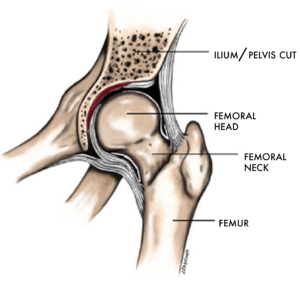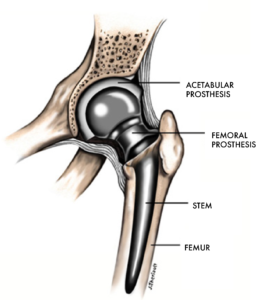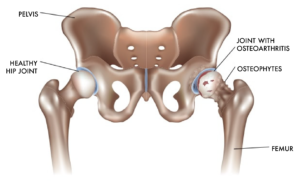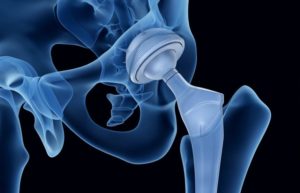Your Total Hip Replacement Is in Good Hands at OSC
A total hip replacement (THR), or total hip arthroplasty in medical terminology, is the surgical procedure which replaces bone and cartilage in the human hip joint. Using a hip implant in a variety of materials customized for each patient, the surgery repairs damage and relieves pain from traumatic injuries or chronic conditions.
The Joint
 Did you know that the hip joints are the single most important element for human balance? Their adjustment determines the pelvic inclination angle, which in turn determines the body’s posture and balance. It’s no wonder that hip joint damage has severe repercussions for every patient.
Did you know that the hip joints are the single most important element for human balance? Their adjustment determines the pelvic inclination angle, which in turn determines the body’s posture and balance. It’s no wonder that hip joint damage has severe repercussions for every patient.
The hip joint’s primary function is to support the weight of the body. It is the chief point of connection between the axial skeleton and lower limbs. Enough damage to the hip joint can prohibit all mobility. Moreover, in elderly patients experiencing osteoporosis, the thin neck of bone that connects the ball of the femur (thigh bone) to the shaft can become fragile enough to snap or fracture. Immediate surgery is necessary to repair this injury. The procedure commonly used in such cases is a total hip replacement.
The Implant
A total hip replacement surgery repairs joint damage with an implant composed of four parts. These mimic the natural ball and socket of the hip. The four parts include:
- a stem inserted into the shaft of the femur for stabilization
- a ball attached to the stem to replace the femur head
- an artificial hip socket inserted into the natural cavity
- a smooth liner for the socket that ensures ease of motion.
Because the procedure recreates the original structure of the joint, it restores patients’ hip functionality and relieves chronic pain, with an up-to 95% success rate after ten years.
The THR Surgery
Due to the complexity and crucial nature of the hip joint, a total hip replacement involves many steps, all carefully executed by the orthopedic surgeon. The surgery occurs with the patient under anesthesia and starts with an incision to expose the joint.
The surgery continues with the removal of the femoral head (the ‘ball’ of the joint). Then, for patients showing signs of arthritic damage, the surgeon carefully trims away affected cartilage and bone from the mouth of the socket to create a smooth surface. Once the cavity is prepared, the surgeon inserts a new socket made of metal or other material, depending on the patient’s needs. Either surgical cement or screws secure this piece, again depending on individual patient. After the socket piece is stabilized, the surgeon inserts an inner liner. This ensures free rotation and smooth motion for the femur head in the socket.
The next steps focus on the femur. First, the surgeon hollows the inner shaft for a long, metal stem which stabilizes the new hip components inside the original bone. The surgeon attaches the ball to the top of the stem. He finishes by inserting the ball into the socket cavity.
A final, indispensable step of the procedure involves testing the new joint for range of motion in different positions. Once certain the procedure has restored mobility, the surgeon closes and bandages the incision. The physician and nurses monitor the patient as anesthesia wears off. Once the patient is ready, they provide instructions for the recovery procedure.
When Is It Time for a Total Hip Replacement?
 There are two major reasons why a patient might consult with an orthopedic surgeon regarding a total hip replacement. The first case is when a major accident has led to a hip fracture. The second is for chronic conditions like osteoarthritis. With the former, since a fracture often prevents a patient from walking at all, the procedure must be immediate.
There are two major reasons why a patient might consult with an orthopedic surgeon regarding a total hip replacement. The first case is when a major accident has led to a hip fracture. The second is for chronic conditions like osteoarthritis. With the former, since a fracture often prevents a patient from walking at all, the procedure must be immediate.
When the need for a total hip replacement depends on osteoarthritis or another chronic condition, the orthopedic specialist does not immediately suggest a total hip replacement. Instead the specialist may prescribe treatments like physical therapy, anti-inflammatories or weight loss, while assessing bone deterioration and risk of fracture. Once it becomes clear that the patient’s quality of life is adversely affected by chronic hip pain and its psychological impact, and that his or her ability to perform daily tasks is critically impaired, then the best form of treatment may be a total hip replacement.
Why Choose Orthopedic Specialty Clinic?

At Orthopedic Specialty Clinic, patients benefit from multiple perks. The clinic can support both inpatient and outpatient procedures. Patients will consult with the surgeon about which will be best for his or her age, health, and overall well-being. If eligible for outpatient surgery, patients will enjoy recovering in the privacy and comfort of their own homes. They will still benefit from nurse visits and access to Orthopedic Specialty Clinic’s on-site physical therapy clinic.
Orthopedic Specialty Clinic is, in fact, the Inland Northwest’s only orthopedic clinic specializing in total hip replacements which also offers all services in a single, convenient location. After the surgery under Dr. Scott’s guidance, the patient will receive the dedicated services of a team of caring physical, occupational, and massage therapists to aid the recovery process.
Success Rates
At Orthopedic Specialty Clinic, we take pride in providing our customers safe and successful procedures for their total hip replacements. Recipients of an OSC total hip replacement are likely to find themselves much more satisfied with their results than patients receiving treatment at other clinics in the country.
According to statistics from the American Joint Replacement Registry (AJRR), on average OSC patients suffer 65% fewer post-op infections to their surgical site. They also spend almost two days fewer in the hospital than do THR recipients throughout the United States in general.
State-of-the-Art Services
Dr. Scott’s expertise in the area of total hip replacement is renowned. He has pioneered many crucial improvements in the field of orthopedics for the Inland Northwest. Working with Dr. Scott for a total hip replacement means receiving access to computer-aided surgery, guided by a camera and computer system. Computer-aided surgery can help the physician customize the surgery for the patient’s anatomy, allowing for less invasive techniques and quicker recovery times. Dr. Scott was the first orthopedic surgeon in the Inland Northwest to test computer-aided technology and helped develop the system for a major manufacturer. Dr. Scott consults with each patient to determine whether computer-aided or equally effective non-computer-assisted techniques are preferable.
In addition, Dr. Scott also offers modular hip implants suited to individual anatomy, as well as a variety of materials and styles. The patient can be sure his or her total hip replacement will achieve maximum comfort. Dr. Scott has also pioneered research on the ceramic-on-metal hip implant. This new technology offers a promising option for younger patients who need a durable implant that can last for decades. Clinical studies have shown minimal wear over the years.
The OSC Philosophy for THR
Dr. Scott also prioritizes minimally traumatic procedures. Some surgeons focus exclusively on minimally invasive techniques, concerned with surface aesthetics of the incision site after surgery. Dr. Scott understands, however, that in a major procedure such as a total hip replacement, the physician’s chief concern should be minimal internal trauma to muscle and nerve tissue. This will make the patient’s recovery smoother and less painful. This approach may result in a slightly larger incision, but Dr. Scott is an expert at achieving a balance between minimal trauma and minimal invasion. His patients report maximum satisfaction with his technique.
At Orthopedic Specialty Clinic, we guide all patients toward the best choices for their lifestyles. The clinic takes pride in offering customized consultations and optimal care for every patient, regardless of the procedure. Patients living with chronic, debilitating hip pain are encouraged to contact Dr. Scott and Orthopedic Specialty Clinic today to determine whether a total hip replacement is the best next step in their treatment.
